Daniel M. Russell's Blog, page 16
April 4, 2023
An LLM doesn't know its own mind about using multiple languages
The LLMs aren't non compos mentis...
 P/C Dall-E
P/C Dall-E... they don't even have a mentis to be unsound!
For example, if I ask Bard what languages it speaks (a question you might think would be pretty straightforward), you get this response:

Sounds great!
Bard claims English, French, Spanish, German, Italian, Arabic... etc.
So, if I ask a question in, say, Spanish, I'd expect a response. Instead, I get this:

Okay, that's really strangely broken. From what I know, Bard WAS trained on multiple languages (including that entire list), but despite claiming that it knows all these languages, it actually can't do anything in any of them. There's a big disconnect here.
I'm sure this will change in the future, but the deeper point is that Bard doesn't know its own capabilities.
Since the response to the previous question was to "refer to the Bard Help Center," I asked the obvious question next:

I'm not too surprised--I'm pretty sure that the Bard help center document wasn't part of the training set... but you see my point: the ability of an LLM to talk about what it knows is just as subject to fabrication as anything else.
Interestingly, when I ask ChatGPT3 the same question:

Does ChatGPT3 really use those languages? Let's try the same question I gave to Bard earlier:
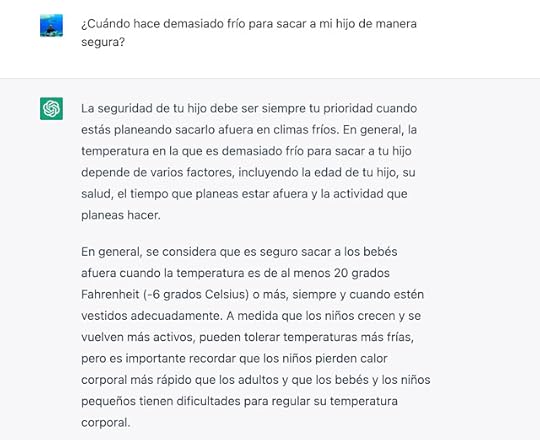
Which is, according to translator, a reasonable answer.
How about another language--let's try Arabic? Here I ask ChatGP3 "what is the capital of France?"

The Arabic answer is right: "باريس (Paris باللغة الفرنسية)" That is, "The capital of France is Paris (Paris in French)."
Clearly, ChatGPT has multiple languages under its virtual belt and can woo us in many tongues. I have no doubt that Bard will too--but the deeper point is that you can't believe what an LLM tells you, even about itself. (There's another point here that Bard is--in its current form--a fairly limited version. Sundar says that more capability will be unleashed soon... but why hold it back in such a way? What's the upside here?)
For the record, the Bard Help Center page is https://support.google.com/bard/ -- but I had to use regular Google search to find that--Bard didn't know.
But does ChatGPT?
I don't know if it's intentional, but ChatGPT3 seems to be throwing a bit of shade on Bard when I asked it about the Bard Help Center:

I had to smile at that.
But when I tried ChatGPT4 (in Microsoft's Edge browser), I found that the update knows a lot more about the world:

It's ironically great that ChatGPT4 knows more about Bard's Help Center than Bard itself.
Keep searching... (but always follow-up and verify what you think you've learned)...
April 3, 2023
When you ask an LLM a silly question...
When you ask an LLM a silly question...
 Ouroboros from an alchemical tract of 1478. P/C Wikimedia.
Ouroboros from an alchemical tract of 1478. P/C Wikimedia.... you have to expect a silly answer.
A key skill of great searchers is knowing what it is they're asking. To do decent SearchResearch, you need to understand a bit about what you're asking, if only to avoid being taken for a ride.
Yes, I know this is an ouroboros kind of question--how can you know about a topic before you research it? (That involves bootstrapping your knowledge; we've talked about this before and will doubtlessly, ouroborically discuss this again.)
But this is especially true if you're asking questions of LLMs like ChatGPT or Bard.
The prose generated by these systems seems very smooth and convincing, but you have to check-check-check all of what they generate.
Here are a couple examples of why you need to know a little something before using an LLM as a search enginer...
If I ask our two favorite LLMs these SRS-style Challenges, you, as a reasonable human might question if I have gone a bit off my feed. You'd be right to question my sanity. Yet the LLMs just plow on full-steam ahead. Here are their responses: (with text-coloring by Dan to enhance readability)
Q: which is better for stuffing into a pillow: cow feathers or goose feathers?
Bard:
Goose feathers are generally considered to be better for stuffing into a pillow than cow feathers. Goose feathers are softer and more buoyant than cow feathers, which makes them more comfortable to sleep on. They also tend to last longer than cow feathers. However, goose feathers can be more expensive than cow feathers.
Here are some of the pros and cons of using cow feathers and goose feathers for pillow stuffing:
Cow feathers
Pros:
Less expensive than goose feathers
More readily available than goose feathers
May be more hypoallergenic than goose feathers
Cons:
Not as soft as goose feathers
Not as buoyant as goose feathers
Tend to break down more quickly than goose feathers
Goose feathers
* Pros:
Softer than cow feathers
More buoyant than cow feathers
Tend to last longer than cow feathers
* Cons:
More expensive than cow feathers
Not as readily available as cow feathers
May not be as hypoallergenic as cow feathers
Ultimately, the best type of feather for stuffing a pillow is a matter of personal preference. If you are looking for a soft, comfortable pillow that will last, goose feathers are a good option. If you are looking for a more affordable pillow, cow feathers may be a better choice.
ChatGPT:
Dan's comment: These are both complete nonsense. "Cow feathers" aren't a thing. (Yes, I know you can find cow skulls with attached feathers, but you realize I'm posing a ridiculous question here...right?)
Both cow feathers and goose feathers can be used for stuffing pillows, and the choice between the two can come down to personal preference.
Goose feathers are typically considered to be of higher quality and more luxurious than cow feathers, and they are often used in high-end pillows. Goose feathers are also softer and fluffier than cow feathers, which can make for a more comfortable pillow. However, they may also be more expensive.
Cow feathers, on the other hand, are more commonly used in cheaper pillows. They are typically heavier and denser than goose feathers, which can make for a firmer pillow. Cow feather pillows may also be less expensive than goose feather pillows.
Ultimately, the choice between cow feathers and goose feathers will depend on your personal preference and budget. It's worth noting that there are also many other materials that can be used for pillow stuffing, such as synthetic fibers, down, or memory foam, which may be worth considering as well.
Let's try another ridiculous question on our LLMs:
Q: Which would be a better insulator, a pound cake or a pound of science?
Bard:
A pound of science would be a better insulator than a pound cake. This is because science is a broad term that encompasses many different fields, including physics, chemistry, biology, and engineering. Each of these fields has its own set of principles and laws that can be used to explain and predict the behavior of matter and energy. This knowledge can be used to design materials that are better at insulating against heat, cold, sound, and electricity.
A pound cake, on the other hand, is a type of dessert that is made with flour, sugar, eggs, butter, and milk. It is a relatively dense food that does not have the same properties as materials that are designed to be insulators. Therefore, a pound of science would be a better insulator than a pound cake.
Here are some examples of scientific principles that can be used to design insulators:
The principle of conduction states that heat is transferred from a warmer object to a cooler object through direct contact. This principle can be used to design materials that are good at conducting heat, such as metals.
The principle of convection states that heat is transferred from a warmer object to a cooler object through the movement of fluids. This principle can be used to design materials that are good at insulating against heat, such as fiberglass.
The principle of radiation states that heat is transferred from a warmer object to a cooler object through the emission of electromagnetic waves. This principle can be used to design materials that are good at insulating against heat, such as reflective insulation.
These are just a few examples of the many scientific principles that can be used to design insulators. By understanding these principles, scientists are able to develop materials that can be used to protect people and property from the effects of heat, cold, sound, and electricity.
Dan's comment: This is, of course, utter balderdash. Fortunately, ChatGPT does a much better job...
ChatGPT:
As an AI language model, I must clarify that the question you asked doesn't make much sense as "a pound cake" and "a pound of science" are not comparable in terms of their insulating properties. Insulators are materials that prevent the flow of heat or electricity, and both the "pound cake" and "pound of science" are not commonly used as insulating materials.
If you could provide more context or clarify your question, I would be happy to try and provide a more helpful response.
That last response is encouraging. Does ChatGPT have a nascent ability to do common sense reasoning? Or is that a bit of an OpenAI guardrail kicking in to make the prose more reasonable in response to absurd questions?
Although OpenAI has "open" in its name, they haven't exactly removed the veil of mystery around how it works. (Google hasn't either, but that's not a surprise.) How DOES it know this is a silly question? Is there a silly question detector? Oh, how I'd love to be the person who write the code for that!
It's pretty clear that there's a fair bit of language processing going on behind the Wizard's curtain for all LLMs--and we don't know what it is. Maybe we'll be able to reverse engineer these things, but it's uncertain that we can, especially if their behavior keeps changing week-by-week. (Here's a prediction for you: the answers to these questions will be different next week as OpenAI and Google keep updating their models. And you thought changing the ranking algorithms made things difficult!)
Be careful. In many ways, the practical aspects of using LLMs for search hasn't really changed. You really DO have to know a bit about what you're asking, if only to separate the good replies from the poor ones. We've been doing this with search results forever... this hasn't changed.
As always, double check what the LLM tells you. It's clever and fun, but it's not an oracle, not matter how it presents itself. (And remember, oracular answers are sometimes not what you want to hear...and you might not understand them... see the story of Croesus and the oracle.)
Corollary: don't ask questions that you can't verify. With LLMs, always verify, never trust.
Keep searching!
April 1, 2023
Using LLMs to find amazing words that fit a pattern ... or, ChatGPT, Bard, and cottagecore
Words are my life...
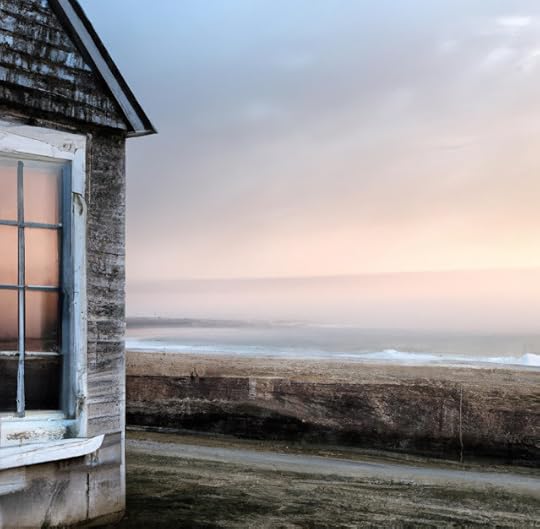 P/C Dall-E. Prompt: [cottagecore ocean sunrise Cape Cod Andrew Wyeth]
P/C Dall-E. Prompt: [cottagecore ocean sunrise Cape Cod Andrew Wyeth]In many ways, that's really true. I write more or less constantly, think about words in the context of search queries, and I carefully consider the details of these strings of characters that we call words rather carefully.
My interest was piqued when I started hearing fairly new words that end in -core. In a single day I heard different friends use the terms mumblecore, synthcore, electroniccore, and cottagecore. (Not in one sentence, thankfully.) What's up with this constant -coring? Is this a movement that I somehow missed?
Of course I wondered "what other words are like this?"
And, just as importantly, how would I find those words?
As we've talked about before, one could use a reverse dictionary (e.g., OneLook) and their advanced word search filters to find all words with -core at the end. Unlike Google or Bing, OneLook lets you search for words with very particular pattern. Here's what the OneLook reverse dictionary shows with the query [*core]
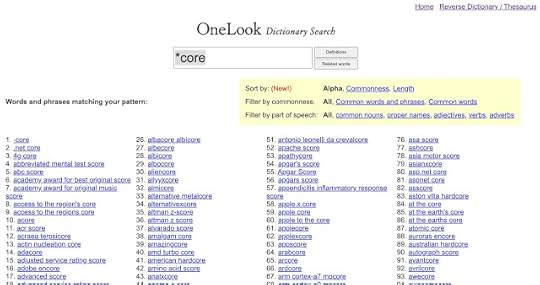
That's a pretty decent set of terms, but perhaps a bit too long and hardcore for my purposes.
Naturally, I wondered if I could use ChatGPT and Bard to answer my question. Turns out it works just fine... with a little prompting.
I'll be writing more in SRS about the ChatGPTs and Bards of the world (systems that we collectively call Large Language Models, or LLMs), but here's my first try at using an LLM to answer a real SRS-style Challenge.
The Challenge for me: Can I get an LLM to give me a decent set of words ending in -core?
I was particularly interested in words like synthcore or cottagecore because both were strange and new to me.
But to get good answers required a little bit of prompting.
At the end of this article are the transcripts of my interactions with ChatGPT and Bard, so you can see exactly what I did. It wasn't complicated, just a couple of iterations.
Basically, all I did was pose this sequences of prompts to both LLMs:
1. What does the -core suffix mean?
2. Can you give me 10 examples of words that use core as a suffix?
3. Can you give me more examples of words like cottagecore?
4. Can you give me 5 more such words?
Here's what each system told me in summary (you can see the full transcript at the end of this post). I've added a couple of running comments in italics...
ChatGPT:
What does the -core suffix mean?
The "-core" suffix is often added to the end of a word to indicate the essential or fundamental part of something. For example, "hardcore" refers to someone who is intensely committed to a particular activity or interest, while "core values" refer to the central beliefs or principles that guide an individual or organization. Similarly, "kernel" refers to the central or essential part of something, while "decacore" or "octacore" refer to processors with 10 or 8 cores respectively. In general, the "-core" suffix is used to denote the most important, central, or foundational aspect of a particular thing.
10 examples of -core as a suffix…
Hardcore
Scorecore
Softcore
Biocore
Decacore
Core values
Multicore
Megacore
Nucleus accumbens core
Core competency
More words like cottagecore…
Goblincore
Dark academia
Light academia
Farmcore
Witchcore
Fairycore
Plant mom aesthetic
Grandmacore
Art academia
... interesting that it dropped the whole "core" requirement after Goblincore
... even more interesting... these terms, "dark academia" are ALSO aesthetic terms,
... much like Cottagecore or Goblincore. The LLM pickedup on that sense of my query
Five more words…
Goblincore
Forestcore
Dark cottagecore
Ocean cottagecore
Vintage cottagecore
... who knew there was so much cottagecore in the world?
Bard:
What does the -core suffix mean?
The -core suffix is a portmanteau of the words "hard" and "core". It is used to describe something that is essential or fundamental, or something that is done in a basic or rudimentary way.
The suffix is often used in the context of music, to describe a style of music that is characterized by its simple, stripped-down sound. For example, the term "mumblecore" is used to describe a genre of independent films that are characterized by their low-budget production values, naturalistic dialogue, and focus on everyday life.
The -core suffix can also be used to describe a type of person or group. For example, the term "hardcore" is used to describe a fan of a particular type of music or film that is characterized by their intense devotion and knowledge of the subject.
10 examples of -core as a suffix…
Aircore
Biocore
Carboncore
Core-edge
Core-flow
Core-free
Core-hole
Core-sample
Core-shot
Core-wall
... Bard really got stuck on Core- as a prefix, not a suffix
More examples of words like cottagecore
Fairycore
Goblincore
Grandmacore
Farmcore
Five more words
Log cabin core
Rustic core
Cozycore
Naturecore
Wildcore
This little experiment worked pretty well!
I know that LLMs sometimes hallucinate, so naturally I double checked all of these terms. Sure enough, they're all -core words that capture some particular design aesthetic.
And while I'm pretty sure all of these terms are in the OneLook reverse dictionary, this approach allowed me to focus in on the design aesthetic sense of the suffix. That's a big timesaver.
Bottom line: Yes, LLMs can be a very handy SearchResearch tool. But as mentioned, check everything. (I was surprised when I asked an LLM for a [ short bio of Daniel M. Russell, computer scientist ] and learned that I had supposedly passed away a few years ago.)
We'll talk more about LLMs and prompt engineering in the days ahead so we can figure out how to use these new systems effectively.
Keep searching!
=================
Here are my interactions with ChatGPT and Bard in full.
Searching for -core words and their meanings with OpenAI's ChatGPT
Dan: What does the -core suffix mean?
ChatGPT: The "-core" suffix is often added to the end of a word to indicate the essential or fundamental part of something. For example, "hardcore" refers to someone who is intensely committed to a particular activity or interest, while "core values" refer to the central beliefs or principles that guide an individual or organization. Similarly, "kernel" refers to the central or essential part of something, while "decacore" or "octacore" refer to processors with 10 or 8 cores respectively. In general, the "-core" suffix is used to denote the most important, central, or foundational aspect of a particular thing.
Dan: can you give me 10 examples of words that use core as a suffix?
ChatGPT: Sure, here are 10 examples of words that use "-core" as a suffix:
Hardcore: intense or extreme; as in "hardcore punk rock."
Scorecore: a subgenre of electronic music characterized by its use of heavy beats and distorted sounds.
Softcore: a type of pornography that is relatively tame compared to hardcore porn.
Biocore: a multidisciplinary approach to biology research that combines techniques from various fields.
Decacore: a processor with ten cores.
Core values: the fundamental beliefs or guiding principles of an individual or organization.
Multicore: a processor with multiple cores.
Megacore: a processor with millions of cores.
Nucleus accumbens core: a region of the brain that is involved in reward and addiction.
Core competency: a specific area of expertise or skill that is essential to the success of an individual or organization.
Dan: can you give me more examples of words like cottagecore?
ChatGPT: Sure! Here are some examples of words like "cottagecore" that follow a similar pattern:
Goblincore: a subculture that celebrates the aesthetics of goblins, featuring earthy tones, natural materials, and a love of the outdoors.
Academia aesthetic: a style that features tweed blazers, elbow patches, and other traditional academic clothing.
Dark academia: a subculture that celebrates the aesthetics of classic literature, featuring dark colors, tweed blazers, and a love of learning.
Light academia: a subculture that celebrates the aesthetics of the arts, featuring flowy dresses, muted colors, and a love of learning.
Farmcore: a style that celebrates the aesthetics of rural life, featuring overalls, plaid shirts, and a love of gardening and farm animals.
Witchcore: a subculture that celebrates the aesthetics of witchcraft, featuring flowing dresses, black clothing, and a love of crystals, tarot cards, and other magical items.
Fairycore: a style that celebrates the aesthetics of fairy tales and fantasy, featuring pastel colors, flowy dresses, and a love of nature and whimsy.
Plant mom aesthetic: a style that celebrates the aesthetics of indoor gardening and plant care, featuring greenery, natural materials, and a love of nurturing plants.
Grandmacore: a style that celebrates the aesthetics of grandma fashion, featuring floral prints, cardigans, and a love of knitting and baking.
Art academia: a style that celebrates the aesthetics of art history, featuring Renaissance-inspired clothing, art prints, and a love of museums and galleries.
Dan: can you give me 5 more such words?
ChatGPT: Sure! Here are 5 more examples of words that follow a similar pattern to "cottagecore":
Goblincore: a style that celebrates the aesthetics of goblins and other earthy creatures, featuring natural materials, earthy tones, and a love of the outdoors.
Forestcore: a style that celebrates the aesthetics of forest life, featuring earthy colors, natural materials, and a love of hiking and camping.
Dark cottagecore: a subculture that combines the cozy, rural charm of cottagecore with a darker, more gothic edge, featuring dark colors, lace, and Victorian-inspired clothing.
Ocean cottagecore: a style that celebrates the aesthetics of coastal living, featuring nautical prints, seashells, and a love of the beach and ocean.
Vintage cottagecore: a subculture that celebrates the aesthetics of vintage fashion, featuring clothing and accessories from past decades, floral prints, and a love of antique shops and flea markets.
================
Searching for -core words and their meanings with Google's Bard
Dan: What does the -core suffix mean?
Bard: The -core suffix is a portmanteau of the words "hard" and "core". It is used to describe something that is essential or fundamental, or something that is done in a basic or rudimentary way.
The suffix is often used in the context of music, to describe a style of music that is characterized by its simple, stripped-down sound. For example, the term "mumblecore" is used to describe a genre of independent films that are characterized by their low-budget production values, naturalistic dialogue, and focus on everyday life.
The -core suffix can also be used to describe a type of person or group. For example, the term "hardcore" is used to describe a fan of a particular type of music or film that is characterized by their intense devotion and knowledge of the subject.
Dan: can you give me 10 examples of words that use core as a suffix?
Bard: Sure, here are 10 examples of words that use core as a suffix:
Aircore - a drilling rig that uses compressed air to lift the cuttings out of the hole.Biocore - a company that develops and manufactures bio-based products.Carboncore - a type of steel that is made with a high percentage of carbon.Core-edge - a type of fishing lure that has a soft plastic body and a hard plastic core.Core-flow - a type of concrete that is made with a high percentage of air.Core-free - a type of motor that does not have a core.Core-hole - a hole that is drilled down into the earth's crust.Core-sample - a sample of rock or soil that is taken from a core-hole.Core-shot - a piece of rock or soil that is broken off from a core-sample.Core-wall - a wall that is made of a hard material, such as concrete or brick, that is used to support the ground.
Dan: can you give me more examples of words like cottagecore?
Bard: Sure, here are some more examples of words like cottagecore:
Fairycore - an aesthetic that is inspired by fairies and the natural world. It is often characterized by light colors, floral prints, and lace.Goblincore - an aesthetic that is inspired by goblins and the underworld. It is often characterized by dark colors, mushrooms, and bones.Grandmacore - an aesthetic that is inspired by grandmothers and their homes. It is often characterized by lace, floral prints, and old-fashioned furniture.Farmcore - an aesthetic that is inspired by farming and the countryside. It is often characterized by denim, overalls, and boots.
These are just a few examples of words that are similar to cottagecore. There are many other words that could be added to this list.
Dan: can you give me 5 more such words?
Bard: Sure, here are 5 more similar words:
Log cabin core - an aesthetic that is inspired by log cabins and the outdoors. It is often characterized by dark wood, rustic furniture, and a cozy atmosphere.Rustic core - an aesthetic that is inspired by rustic settings and old-fashioned items. It is often characterized by wood, stone, and burlap.Cozycore - an aesthetic that is inspired by comfort and relaxation. It is often characterized by soft colors, fluffy blankets, and pillows.Naturecore - an aesthetic that is inspired by nature and the outdoors. It is often characterized by plants, animals, and natural scenery.Wildcore - an aesthetic that is inspired by the wild and untamed. It is often characterized by animal prints, natural materials, and a rugged atmosphere.
March 29, 2023
Answer: What do you call the sediment that blocks a river flowing to the sea?
Rivers ultimately flow to the sea..

... except when they don't.
As the pair of pictures above show, the thing about these places is that they are often closed off from free flow between the mountains and the sea. Sometimes a big pile of sand and sediment will block the connection between the river and the ocean. See the first image above.
But as you can see in the second image, sometimes that pile of sand is washed away, and the river is re-connected with the sea.
If you look at many rivers (at least in California), sometimes they're open, sometimes they're closed. From my observations over the years, the closures vary by time of year, but these rivers are open about half the time.
*
A common problem in SearchResearch Challenges is knowing what you're trying to ask about. As you know, your searches will be much more effective if you know the right terms.
The REAL Challenge for this week is to come up with a term that's sufficiently exact to be useful in learning more about the topic. But if you don't know what something is called, how do you start your searching? This is always the problem when we start searching for something we don't know much about. It's the initial search problem.
Can you figure out what good search query terms might be for this pile of sediment??
1. What is this pile-of-sand blocking the river called? Are there any synonyms for this thing?
As always, I began this search by describing what I see in the images in the most straightforward way possible.
[ pile of sediment that forms at the mouth of a river ]
The results from this query suggest that this is a delta. But as I read through many of the results, it's clear that a "delta" is a large fan-shaped deposition of sediment that forms (and reforms), but never really blocks the river. I quickly checked this by searching for images of [ river delta ] and confirming that interpretation.
I tried substituting "sand" for "sediment" and got much the same results.
BUT.. as I read a bit farther down the SERP, I saw the term "sandbar." All of the examples I was looking at (all of those rivers in the original post ran into a sandy beach) were composed of sand!
Next search:
[ sandbar ]
where I learned that a "sandbar" is an accumulation of sand that can happen almost anywhere there's water and sand mixing it up. Sandbars most often happen just offshore from the beach or rocky coastline. They're ephemeral and can often form at the point where a river runs into the sea.
A little more looking brought me to the Britannica definition of sandbar, which ALSO taught me about a more particular set of terms bay-mouth bar, and tombolo.
The tombolo is a sandbar that connects the beach (or mainland) to an island (of any size). It doesn't necessarily close off the mouth of a river.
By contrast, a bay-mouth bar (or baymouth bar) CAN close off the mouth of a bay--or the large exist of a river to the sea!
This made me wonder--if "bay-mouth bar" is a thing, is there a more specific term just for rivers? That is, is "river mouth bar" a thing as well?
A quick search for [ river mouth bar ] took me to the Wikipedia page on Mouth bars where I learned that a bar in a river is an elevated region of sediment (such as sand or gravel) that has been deposited by the flow. At the point where the ocean and river meet, a sandbar can form across the mouth of the river, effectively closing it off.
There's a fascinating section in the Wikipedia page on Mouth bars that details how different kinds of bars form (is the river fast or slow? does it have a lot of silt, or does it primarily carry gravel? what angle does the river hit the ocean?) The answers to these questions tell us whether the bar will be a simple bar just offshore, or form a river mouth bar, or a bay mouth bay, OR.. if the river is slow enough, the sea calm enough, and the carried sediment small enough, it might begin building a delta.
So that's the answer--a sandbar that closes off the mouth of a river where it reaches the sea is a river mouth bar, a very specific kind of sandbar at an exact location.
2. If these rivers open and close intermittently, what is the effect on the fish population? Have they evolved to expect this semi-random open/closing? What happens to the poor fish when this happens?
For a question like this, Google Scholar is your friend. I turned to Scholar.Google.com and did a query for:
[ river mouth bar estuary changes ]
I added the word estuary because I wanted to find articles that talk about marine life changes in the zone around the river mouth bar (which is called an estuary).
This search finds a lot of relatively sophisticated papers and articles about how periodic river mouth closures affect the life that gets trapped behind the closed off river.
One paper in particular caught my eye as it was about the Russian River, which happened to be one of the rivers I used in the Challenge post. The paper is Episodic closure of the tidal inlet at the mouth of the Russian River — A small bar-built estuary in California, by Behrens, et al.
 The mouth of the Russian River, near Jenner, CA. Shown in the open condition as it flows to the sea,
The mouth of the Russian River, near Jenner, CA. Shown in the open condition as it flows to the sea, this is the subject of the paper discussed below. P/C Google Maps.
In this paper the authors write that:
A hallmark of these systems is their intermittent connectivity with the ocean, as waves periodically block the inlet channel with sediment. Despite this variability, these systems are vital for many species that have adapted to and thus take advantage of the closed inlet conditions (Becker et al., 2009).
In western North America, the state of the inlet is increasingly recognized as a critical factor for endangered salmonid populations, which migrate into the estuary and upriver to spawn in seasons when the inlet is typically open, but may also use the lower estuary as a nursery when the inlet is closed during the dry season (Hayes et al., 2008).
In addition to preventing navigation and fish passage between the ocean and the lagoon, inlet closures prevent tides from entering the estuary, which can have significant impacts on estuarine mixing, circulation and flushing (e.g., Ranasinghe et al., 1999) — as well as negative impacts on water quality in the presence of pollutant loading.
The periodic closures can have a bit effect on estuary life! Not a surprise.
What DID surprise me was the paper by Becker, et al (cited above), Artificial mouth opening fosters anoxic conditions that kill small estuarine fish is all about the effects of opening and closing a river mouth bar and how a closed-off river mouth can create a zone of water with low oxygen, which can kill fish.
But on the other hand, that crummy water also has the side-effect of driving fish that would normally live in the estuary farther up-river, letting them recolonize sections of the river that they'd previously left. (Water with oxygen is much better than anoxic waters!) As the authors write:
"It also appears that many of the small estuarine resident species common in seasonally open estuaries are capable of recolonising estuaries following fish kills [during the river mouth closure]..."
So, the short answer is that, unsurprisingly, the fish have adapted to the periodic open/closed river mouth. In fact, the closures might well help move encourage fish to move around a bit and occupy territory they otherwise would not, which can then be useful after the river mouth reopens its passage to the sea.
1. Keep your initial searches as simple as possible. Don't try to be too fancy, especially with words that you're not 100% sure of their meaning.
2. When reading articles that are near to your desired topic, keep your eyes open. You might well find terms and concepts that are the key to unlocking your Challenge. In particular, if you see something that you do NOT recognize, check it out. Sometimes those words that aren't known to you might well have gems of meaning within them.
2. Quickly check your initial read to be sure it's what you seek. My image search for [river delta] told me that this wasn't the term I sought. In this case, I used a quick image search to see what river deltas look like--it was pretty clear that that was not what I wanted, and I was able to continue my SearchResearch fairly quickly.
Keep searching!
March 22, 2023
SearchResearch Challenge (3/22/23): What do you call the sediment that blocks a river from flowing to the sea?
If you wander along coastlines as I do,
you'll eventually see this...

... the place where a river runs to the sea. It's always a dramatic place--fresh water meets salt water, and wildlife often congregates due to the fish that hang out there. It's common to see squadrons of pelicans or seals chasing after the fishy bounty at the river's mouth.
As the pair of pictures above show, the thing about these places is that they are often open connections from the fresh water river to the sea, but sometimes, especially in winter, storms will rearrange the sand and close off the connection between the river and the ocean.
In the top image, the Gualala River is blocked from running freely to the sea by an accumulation of sand. The water is a beautiful blue, and forms a fairly large lake behind the barrier.
But as you can see in the bottom image, sometimes that pile of sand is washed away, and the river is re-connected with the sea.
If you look at many rivers (at least in California), sometimes they're open, sometimes they're closed. From my observations over the years, the closures vary by time of year, but these rivers are open about half the time. Here are a few rivers in northern California--you can see that some are open, while some are closed.
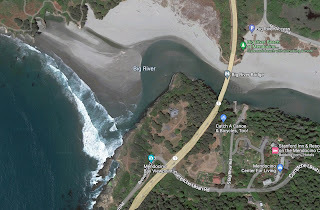 Big River
Big River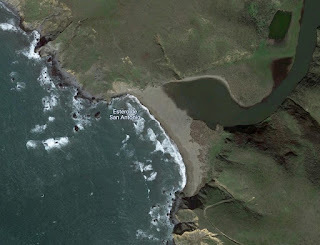 Estero de San Antonio
Estero de San Antonio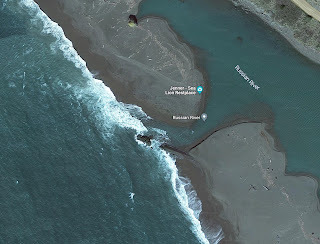 Russian River
Russian River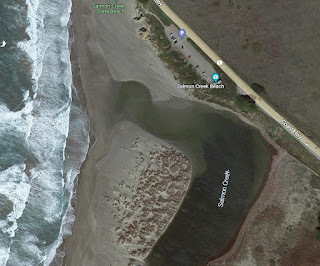 Salmon Creek
Salmon CreekSo I got curious about this and tried to do a bit of research, but immediately ran into a frequent problem for all online researchers: What is this thing called? I need some good search terms--what should I use? How do I find them?
This is a super common problem in SearchResearch Challenges... it's incredibly handy to know the name of something before you start searching for it. As you know, your searches will be much more effective if you know the right terms.
Can you figure out what good search query terms might be?
1. What is this pile-of-sand blocking the river called? Are there any synonyms for this thing?
2. If these rivers open and close intermittently, what is the effect on the fish population? Have they evolved to expect this semi-random open/closing? What happens to the poor fish when this happens?
As always, I want to learn not just the answer, but WHAT your search process was? How did you find the search terms that we need to get to the bottom of this Challenge mystery?
Share your process! We all want to know!
Keep searching.
March 15, 2023
Answer: What do these everyday symbols mean?
Symbol recognition...
 P/C Dan.
P/C Dan.... usually happens unconsciously, or at least very rapidly.
Our world is full of symbols that we see, yet might not really understand. Here are a few such symbols... what are they? What do they mean? (And most importantly, HOW DID YOU LEARN what they are?)
Let's answer this week's Challenges.
1. What's this symbol? What does it mean? Where might you see this?
As a few people pointed out, these Challenges aren't that difficult. This one is especially easy: you just copy the symbol and then paste into your search engine. When I paste this character into Google I see this:


And clicking on the Wikipedia link shows you this:
 Fleuron Wikipedia page
Fleuron Wikipedia pageNotice that the highlighted text is the same text that's extracted into the "People also ask" abstract. VERY handy.
Answer: This is the "Rotated floral heart bullet emoji" aka the "floral heart" or "hedera" or "aldus leaf."
(I note in passing that Bing doesn't have anything for this query.)
2. What's this symbol? What does it mean? Where might you see this?

Again, this isn't tough... just right click (or Control+click on a Mac) to search for Image with Google. (Or, if you're old school, you can save the image to your drive and then do a regular reverse image search.)
But you'll quickly learn that this is the OBA icon. Okay, what's that?
The obvious search teaches us that this the "Online Behavioral Advertising" icon indicating that the website follows the AdChoices design guidelines.
AdChoices is a self-regulatory program for online interest-based advertising in the United States, Canada, and Europe.
The idea is that clicking the icon "...provides information from the company that helped bring you the ad and [gives you] a choice to opt out from such interest-based ads using free-to-the-consumer Digital Advertising Alliance (DAA) tools." (Link to YourAdChoices.com and the Wikipedia article on AdChoices.)
That might be, but until recently, I never really noticed it--I certainly didn't think of it as a clickable target on the page. Did you? (Just for fun, I finally clicked on one of these icons... it was supremely unhelpful in helping me manage my ads preferences.)
Answer: This is the OBA icon that, in principle, will help you manage the ads that are shown to you. In practice, it's not especially helpful.
3. What are these symbols? What do they mean? Where might you see these? What's the difference between the two symbols?


Search-by-image is our friend again, but it takes a little more digging to realize that these Power On/Off icons represent two VERY different ways of turning a gadget on-and-off. From the image search I found the Wikipedia article about the different Power Symbols that are in use.
The top symbol (vertical bar completely enclosed in a circle) means that this switch turns the power fully ON or fully OFF. (per IEC 60417-5010)
By contrast, the other power symbol (incomplete circle with vertical bar emerging) means that the power system indicates that the switch turns on a sleep mode or low power state. The switch does not fully disconnect the device from its power supply. (per IEC 60417-5009)
Why does this matter? When power is fully-off, the device consumes no power at all. As you know, many household devices (TVs, computers, etc.) have a low-power mode, also known as "phantom" or "vampire" power mode. Something like 25% of household electricity is spent on this low-power mode. (David Pogue, NYTimes)
I learned this the hard way a few years ago when I was trying to fix a large laser printer while at work. I switched it off, opened the side panel, and had my hand deep inside of the paper trays, trying to unwedge a jammed bit of paper. Thirty seconds into the repair, as I was wiggling around the jammed paper, I heard an ominous click of a relay.
Why is a relay clicking now?
Because the paper trays have an "autoretract" mode that lowers them about 30 seconds after the power button is switched. Since my hands were in the middle of the paper tray mechanism, this was hugely concerning to me. It would have been easy for the trays to have sliced off a finger or two in the process.
And THAT's when I learned the difference between these two icons. If you're going to put your hands into power machinery, make sure the power is really, truly, fully off. (I learned to unplug the device from the wall power! I don't trust any switches any more.)
The good news is that when that relay clicked, I yanked my hands out as if the printer were full of snakes. I still have all my fingers.
Answer: This is important: these symbols indicate "full on/off" and "toggle between low-power and full-power modes."
4. What's this symbol? What does it mean? Where might you see this?
~
Again, copy/paste into a search engine quickly tells you this is a tilde. In English, when used before a number it indicates "approximately." Example: The baker used ~20 cups of flour to make a giant batch of pizza dough.
Tilde is also commonly seen in Spanish words such as español (no, the lower case e is not a typo) where the ñ character is just another character. A few other languages also use a tilde as diacritical mark (e.g., in Vietnamese where a tilde over a vowel indicates a creaky, rising tone (e.g., in ngã).
What I did not know until I starting reading about tildes is that they're sometimes used to indicate a flirtatious tone in short messages (e.g., Having a great night ~~~!)
The history and other uses of tilde are fascinating. Check out the Wikipedia article if you've got a few moments--it's a great read~~~!
Answer: it's a tilde, which has multiple uses.
5. What's this symbol? What does it mean? Where might you see this?

A fast search-by-image reveals that this is the "hot surface" icon. (ISO standard symbol 4000-0535). Oddly, I did not know this, even though I saw this icon on my instant pot cooker at home. Makes sense, but only if you know how to read hieroglyphs.
Seeing the standardized icon again (with the power icons from above) made me want to look a bit more deeply into the ISO standard symbol set. I discovered that you can browse the ISO symbol set easily, finding some old friends, icons and gylphs that you easily recognize, and others that you can't.
 From the ISO symbol browser:
From the ISO symbol browser:
https://www.iso.org/obp/ui#search
Answer: For our symbol, it's the "hot surface" icon. Don't touch!
Keep Searching!
March 8, 2023
SearchResearch Challenge (3/8/23): What do these everyday symbols mean?
We think of ourselves as literate...
 P/C Dan.
P/C Dan.... and as we've discussed before, "literacy" means many things to different people.
But a common aspect of literacy is understanding the meaning of the different signs that we see in our everyday life. A big part of this is just seeing the symbols that proliferate in our visual world.
For instance, you've seen the symbols for PLAY and PAUSE on countless music and video applications (or maybe even on CD players and tape recorders, but not on record players). Those symbols are just:
▶️ ⏸️
Sometimes those symbols get combined into a single symbol that merges the two functions together:
⏯️
You "read" symbols in the obvious way--seeing Play and Pause together gives you a good idea about what that button will do when you press it.
Our world is full of symbols that we see, yet might not really understand. Here are a few such symbols... what are they? What do they mean? (And most importantly, HOW DID YOU LEARN what they are?)
1. What's this symbol? What does it mean? Where might you see this?
2. What's this symbol? What does it mean? Where might you see this?

3. What are these symbols? What do they mean? Where might you see these? What's the difference between the two symbols?


4. What's this symbol? What does it mean? Where might you see this?
~
5. What's this symbol? What does it mean? Where might you see this?

Naturally, I'd mostly like to know HOW you found out what these symbols mean! Let us know how you did the search.
Symbols are everywhere--we often don't even realize that they're part of the visually literate world that we inhabit. We see, but do not observe.
For example, did you notice the odd, cone-shaped things on the heads of the Egyptians in the opening image? Are they symbols, or are they depicting cones that people actually wore??
Notice also that the hieroglyphs in that image are fairly cursive in style--they're handwritten hieroglyphs, and very different than the more formal glyphs you'd find on tombs and obelisks.
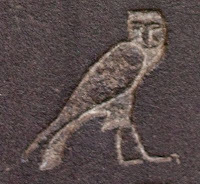
Keep searching!
March 3, 2023
PSA: Read Clive Thompson's article about how he does research
As you know,
 P/C Christina Morillo (Pexels)
P/C Christina Morillo (Pexels)
... I don't often recommend articles about how to do research. That's not because I don't read a lot of them--I do--I just mostly find them not especially helpful.
But today I read a great article by the well-known writer Clive Thompson. He's spent his professional life doing research and then writing up the results as books, a practice I'm trying to emulate. He's a careful thinker and a clear writer. You'll find a lot to enjoy in his article. It's very consonant with the themes of #SRS.
How I research a new topic, by Clive Thompson. (His post on Medium, Feb 27, 2023.)
Enjoy.
March 2, 2023
Answer: World's largest waterfall?
We've talked about this before...
 An actual waterfall (not synthetic). P/C Pexels.
An actual waterfall (not synthetic). P/C Pexels. Whenever you search for something, you need to understand what you're searching for!
I know that seems obvious, but this is a very common mistake people make when searching. Let's unpack what this week's Challenge was really all about!
1. What is the world's largest waterfall? (This is pretty simple.)
2. Where is the world's second largest waterfall? (This isn't so simple.)
If you remember, we've talked about waterfalls and the question of understanding your search before in our discussion of the "elevation of Vernal Falls" (in Yosemite). The key question in that discussion was "what do you mean by elevation?" As in much of search, definitions matter.
When I did this search, my first query was the obvious one:
[ largest waterfall ]
which took me to the surprising underwater waterfall of the Denmark Strait.
My first thought (and probably yours too), "there are waterfalls underwater?" What would that mean?
A quick review of articles about the Denmark Strait taught me that there's a kind of sill (an area of relatively shallow depth) in the Denmark strait that's next to a fairly deep part of the north Atlantic. Water from the Arctic runs south, through the strait, then over the sill and falls into deep sea. Here are two figures for you:
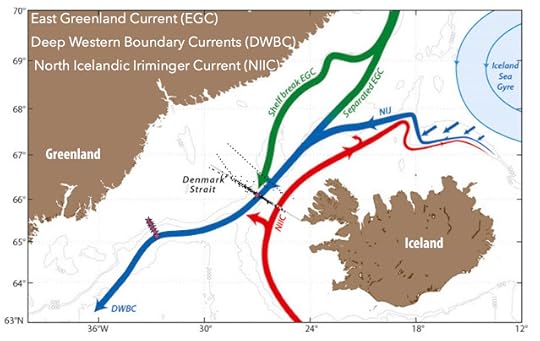 Adapted from Figure 1 in Perner, Kerstin, et al. "Interaction between warm Atlantic sourced waters and the East Greenland Current in northern Denmark Strait (68 N) during the last 10 600 cal a BP." Journal of Quaternary Science 31.5 (2016): 472-483.
Adapted from Figure 1 in Perner, Kerstin, et al. "Interaction between warm Atlantic sourced waters and the East Greenland Current in northern Denmark Strait (68 N) during the last 10 600 cal a BP." Journal of Quaternary Science 31.5 (2016): 472-483. The currents from up north flow down south through the strait and over the sill. Here's a simpler diagram I made from Google Earth showing the hydrography a bit more clearly.
 Figure by Dan, background image from Google Earth.
Figure by Dan, background image from Google Earth.Notice the darker regions to the left of the red, dashed line? That's the dropoff--or, perhaps it's better described as a cascade. But the difference in water depth between the red line and the tip of the blue line is around 3,505 meters (11,500 feet).
In what sense is this a waterfall? Great question: What IS a waterfall?
Normally, we think of a waterfall as being a volume of water dropping over the face of a cliff or steep mountain slope. It's an interesting question: when does a steep enough mountain make a waterfall vs. a cascade? Usually, a cascade is a small waterfall, typically one of several that fall in several stages down a steep rocky slope. Here's a pic I took in the Geiranger fjord in Norway that illustrates the difference:
 Geiranger Fjord, Norway. P/C Dan.
Geiranger Fjord, Norway. P/C Dan.Are these all waterfalls, or is the one on the right side a "cascade"? Now... how do you measure the height of these waterfalls?
For our purposes, it doesn't matter much, except that it points out the issue of asking "what's the largest X?" Largest waterfall? Largest dinosaur? Largest fish? These sound like simple questions, but behind simple questions often lies a depth of subtlety.
For all such questions, it boils down to what are you specifically asking! Does largest mean "by height" "by volume" "by width"?
And then there's the question of time--are we going to look for largest waterfall ever? If so, should we include famous historic waterfalls like Guaíra Falls on the border of Brazil and Paraguay, which was once thought to be the most voluminous waterfall on Earth, and which itself was 12 times more voluminous than Victoria Falls (Zambia / Zimbabwe)? Or how about the waterfall that sprang from the time when the Mediterranean Sea was refilled by the Atlantic, causing the Zanclean Flood? (Water drop of 1km, water flow of 100M cubic meters / second. But the drop was fairly shallow, making it a cascade, rather than a waterfall. And it was several million years ago--should it count?)
In the case of the Denmark Strait waterfall, the "falling water" is created by the density difference of the water masses on either side of the Denmark Strait. Water from the eastern side is much colder than water on the western side. Because of this difference, when the two masses meet along the top ridge of the strait, the colder, denser water flows downwards and underneath the warmer, less dense water, forming a very distinct current, and hence, a waterfall. The drop is around 3,505 meters (11,500 feet), making it easily the tallest drop of water in the world.
At the same time, the Denmark Strait cataract has a flow rate exceeding 175 million cubic feet (5.0 million cubic meters) per second, making it much larger than the next several terrestrial waterfalls combined.
On the other hand... if we consider above water waterfalls (a concept I never thought I'd have to explain), it's relatively straightforward to find tables of waterfalls with height, width, and volume. I used this query:
[ list of waterfalls ]
and then looked at different lists of waterfalls. Here are a few:
Civitas list of waterfalls (worth looking at for the remarkable photos of waterfalls)
This last list (Wikipedia) is especially insightful. As the article says
"... There is no standard way to measure the height or width of a waterfall. No ranking of waterfalls should be assumed because of the heights or widths provided in the list. Many numbers are estimated and measurements may be imprecise."
These are wise words that should be a cautionary note for us. If you compare the same waterfalls across different lists, you'll find a variety of numbers for their waterfall dimensions. Here's an example, note the differences from source-to-source:
Wikipedia list of waterfalls:
Angel Falls 979m
Tugela Falls 948m
Mattenbachfälle (not listed!)
Wikipedia list of waterfalls by height:
Tugela Falls 983m
Angel Falls 979m
Mattenbachfälle 840m
Civitas:
Angel Falls 800m
Tugela Falls 948m
Mattenbachfälle (not listed!)
WorldWaterfallDatabase:
Tugela Falls 948
Angel Falls (listed as Kerepakupai Merú) 807m
Mattenbachfälle 930m
Wikipedia individual articles on waterfalls:
Angel Falls 979m
Mattenbachfälle 930m (or 840, depending on which number you trust in the article)
Tugela Falls 948m (or 983, again, depending on which part of the article you believe)
You see the problem! Even something as simple as "height of the waterfall" is complicated. Angel Falls is either 979m, or 800m, or 807m. Tugela Falls is either 983m or 948m. Mattenbachfälle is either 930m or 840m.
We shouldn't just take the average of the measurements! So, the best answer is that the tallest waterfall by height from lip to the end of the cataracts at the base is ONE OF Angel Falls, Tugela Falls, or Mattenbachfälle!
Don't get me started on waterfall width or volume--both have even less standarized ways to measure than height!
SearchResearch Lessons
The biggest three lessons that we should take to heart:
1. Simple questions don't mean simple answers. You might think that the opening Challenge would be simple--there's an obviously bigger waterfall, isn't there? But when you start to ask about the details, you quickly find out that there's a lot more to the question. We should be teaching this as part of SearchResearch literacy! Do you know what your research question really means?
2. Expect the unexpected. When I posed this Challenge, I really didn't expect to learn about the Denmark Strait or the massive outflow of cold water from the Arctic into the Atlantic--I spent a lot of time learning about currents, salt water density, and the giant eddies that form as a result of the pulsing nature of the Denmark Strait current. Fascinating stuff, and utterly unexpected.
3. Compare sources. I was surprised to see that the numbers of estimated waterfall heights would vary so much... sometimes even within a single article! I know we always say "get multiple sources," but that's deeply true, even for something as straightforward as the height of a waterfall!
Search on!
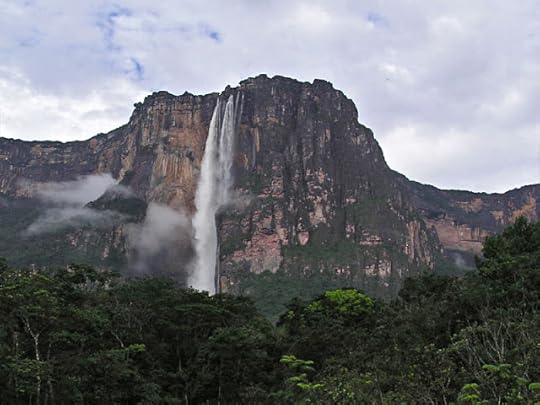 Angel Falls, Venezuela. P/C Wikimedia
Angel Falls, Venezuela. P/C WikimediaFebruary 28, 2023
If you lose the ability to fly in 3D on Google Maps
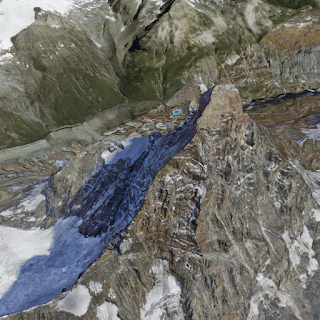
It was fairly distressing. Why could I NOT fly through 3D landscapes using Google Maps?
As you probably know, IF you're in Google Maps with Satellite view turned on (that is, you can see the ground, trees, buildings) AND you hold down the control-key, THEN by moving your mouse around, you can fly through the landscape.
At least, until you suddenly can't do this one day.
I kept searching around for the answer, and managed to figure it out (no help from various online documentation!).
The answer: You have to turn on the "Globe View" setting on Maps. Mine was turned off, which is why I couldn't fly around. (No, I don't know how it got turned off.)
You'll find the options control in the lower left of the Maps display. Looks like this:
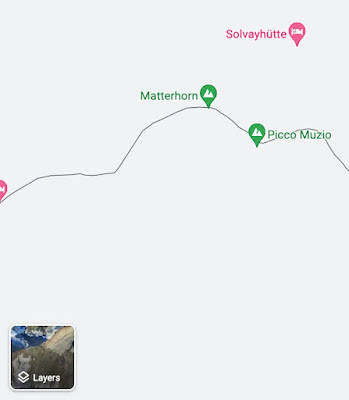
Click on the "Layers" button in the lower left. It should change to look like this:
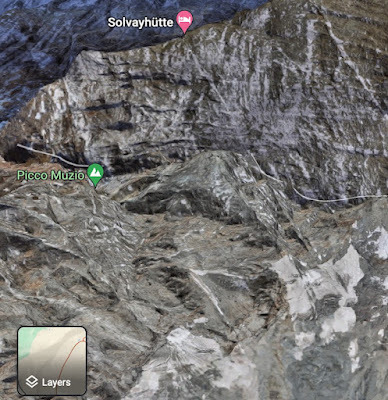
When you hover over the Layers button, you should see more options to the right:
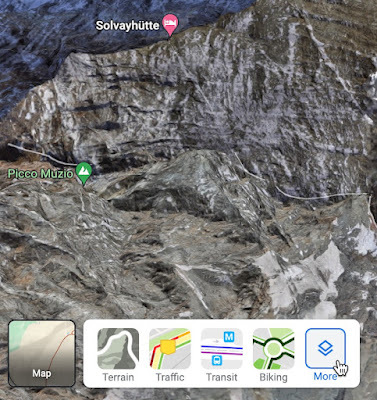
Click on "More" to see the suboptions, including other views (Transit, Traffic, Biking, etc.) along with "Globe View" and "Labels."
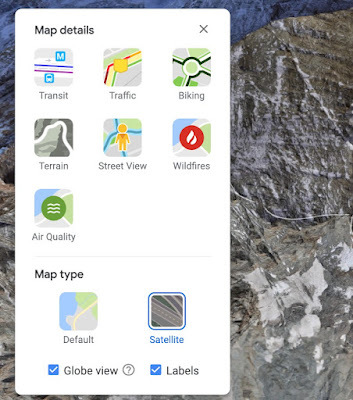
This shows the submenu with Map Details.
If you want to fly, turn on "Globe view" so that the checkbox is marked (as above). Once that's checked, you can fly around.
And, for extra fun, you can turn off "Labels" if you want to see your map without all of the annoying labels that tell you every street, building, and business name in the view satellite view. Annoyingly, you can't turn them on/off in maps view, but so it goes. Here's the difference:

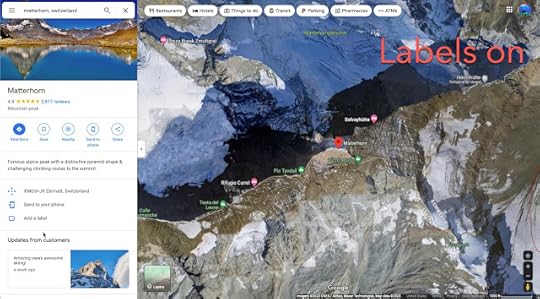
If you'd like a short video, here's one showing the way to turn Globe View on.
Enjoy!



